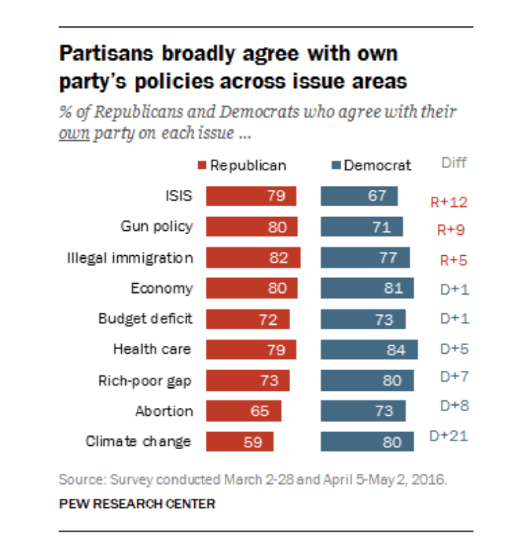4.1: What Is a Political Party?
- Page ID
- 129152
So, what are political parties? Political parties are organizations with a specific set of values and beliefs that aim to gain control of government so that they can influence policy. Political parties seek power, and the way they do that is by winning office. Political parties thus serve a number of useful functions like selecting candidates, raising money to fund campaigns, and providing a party label to aid you as a voter in selecting the right candidate to vote for when you do not know anything about the candidate.
Ideology vs. Party
Political parties represent ideologies but the two are not the same. Political ideology is set of ideas, attitudes, or values about government and politics held by individuals. Currently the Republican Party represents a conservative ideology, and the Democratic Party represents a liberal ideology. These ideologies lead to different positions on policies. The differences among these groups comes down to how they view government involvement, whether or not they want a more limited or more active role for the government in the economy or in such social issues as abortion or gay marriage. Here’s a look at political ideology so you can better understand why political parties pursue certain policies Liberals On the economic dimension, a liberal favors policies to equalize the inequalities in income. Liberals favor a positive government role. In other words, liberals want the government to take an active role in equalizing those inequalities. Liberals take ownership of certain issues like the environment and expansion of social services.
On the social dimension, liberals value government intervention for environment, equality, and minority rights however, they want government out of social issues. So, on the social dimension, issues like climate change are often embraced by liberals and they want the government to take action to slow or stop climate change.
Conservatives On the economic dimension, a conservative wants limited government involvement, and they favor capitalism and policies to promote economic
growth. Conservatives, on the social dimension, feel that religion and traditional family values are important, and they want government to promote these through intervention if needed.
For Further Reading:
Political Typology Quiz
Take the Pew Typology quiz to see where you fall on the ideological spectrum and what percentage of the U.S. population is the same as you.
Partisanship
You have seen that political parties organize to represent a political ideology. Ideology, however, is associated with but not the same as partisanship, or loyalty to a particular party. People who are partisan, strong supporters of the party, seem to agree with their political party’s position on most if not all issues like the economy, environment, immigration, guns, and health care (Figure 4.2). But you can be conservative or liberal no matter what parties happen to exist in a given country or point in time.

Third Parties
Democrats and Republicans are not the only parties, though they dominate what has come to be called our two-party system. Third Parties have played a significant role in politics, from the anti-immigration American Party of the 1850s, to the agrarian People’s Party that grew out of the Grange movement and was particularly influential in Texas after the Civil War, to the Progressive Party, founded in 1912 by former president Theodore Roosevelt to run for president after he failed to win the Republican nomination and which ultimately ushered in a slew of social reforms such as minimum wage and women’s right to vote, and more recently the La Raza Unida Party of the 1970s that championed Latino rights and won many local elections in South Texas.
Third Parties that are most active in Texas today are the Green Party, advocating environmentalism and social justice, and the Libertarian Party, advocating an individual autonomy, or self-government, ideology.
Libertarians are particularly strong in Texas, with over eighty Libertarian candidates on the ballot in 2020.1 On the economic dimension, a Libertarian is in agreement with conservatives in that they want limited government involvement and favor capitalism and policies to promote economic growth. On the social dimension of ideology, Libertarians differ from conservatives. Libertarians want little government involvement in social matters and instead prefer that social matters be left up to the individual to decide. All in all, Libertarians want a limited government who does not take an active role in the lives of its citizens. Ron Paul probably the most well-known Libertarian from Texas put it this way: “If you like small government you need to work hard at having a strong national defense that is not so militant. Personal liberty is the purpose of government, to protect liberty—not to run your personal life, not to run the economy, and not to pretend that we can tell the world how they ought to live.”2 Paul served in Congress from 1976-1977, 1979-1985, and 1997-2013, and ran for president in 2008.
For Further Reading:
In close elections, two opponents can be better than one
Read this analysis of effect of third parties on elections in Texas.
1. “More than 80 Libertarian candidates will be on the ballot across Texas in 2020,” Libertarian Party of Texas, https://www.lptexas.org/.
2. Ron Paul. AZQuotes.com, Wind and Fly LTD, 2021. https://www.azquotes.com/quote/226910.

